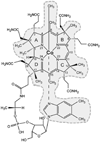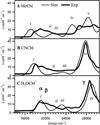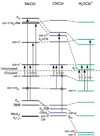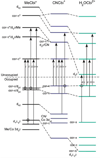Combined spectroscopic/computational studies of vitamin B12 precursors: geometric and electronic structures of cobinamides
- PMID: 22332807
- PMCID: PMC4656031
- DOI: 10.1021/ic202052g
Combined spectroscopic/computational studies of vitamin B12 precursors: geometric and electronic structures of cobinamides
Abstract
Vitamin B(12) (cyanocobalamin) and its biologically active derivatives, methylcobalamin and adenosylcobalamin, are members of the family of corrinoids, which also includes cobinamides. As biological precursors to cobalamins, cobinamides possess the same structural core, consisting of a low-spin Co(3+) ion that is ligated equatorially by the four nitrogens of a highly substituted tetrapyrrole macrocycle (the corrin ring), but differ with respect to the lower axial ligation. Specifically, cobinamides possess a water molecule instead of the nucleotide loop that coordinates axially to Co(3+)cobalamins via its dimethylbenzimidazole (DMB) base. Compared to the cobalamin species, cobinamides have proven much more difficult to study experimentally, thus far eluding characterization by X-ray crystallography. In this study, we have utilized combined quantum mechanics/molecular mechanics (QM/MM) computations to generate complete structural models of a representative set of cobinamide species with varying upper axial ligands. To validate the use of this approach, analogous QM/MM geometry optimizations were carried out on entire models of the cobalamin counterparts for which high-resolution X-ray structural data are available. The accuracy of the cobinamide structures was assessed further by comparing electronic absorption spectra computed using time-dependent density functional theory to those obtained experimentally. Collectively, the results obtained in this study indicate that the DMB → H(2)O lower axial ligand switch primarily affects the energies of the Co 3d(z(2))-based molecular orbital (MO) and, to a lesser extent, the other Co 3d-based MOs as well as the corrin π-based highest energy MO. Thus, while the energy of the lowest-energy electronic transition of cobalamins changes considerably as a function of the upper axial ligand, it is nearly invariant for the cobinamides.
Figures










Similar articles
-
Spectroscopic and computational studies of Co3+-corrinoids: spectral and electronic properties of the B12 cofactors and biologically relevant precursors.J Am Chem Soc. 2003 May 14;125(19):5897-914. doi: 10.1021/ja029328d. J Am Chem Soc. 2003. PMID: 12733931
-
Accurate redetermination of the X-ray structure and electronic bonding in adenosylcobalamin.Inorg Chem. 2004 Feb 23;43(4):1235-41. doi: 10.1021/ic0348446. Inorg Chem. 2004. PMID: 14966957
-
Assessment of the existence of hyper-long axial Co(II)-N bonds in cobinamide B(12) models by using electron paramagnetic resonance spectroscopy.J Am Chem Soc. 2001 Apr 11;123(14):3358-66. doi: 10.1021/ja004024h. J Am Chem Soc. 2001. PMID: 11457072
-
Methylations in vitamin B12 biosynthesis and catalysis.Curr Opin Struct Biol. 2022 Dec;77:102490. doi: 10.1016/j.sbi.2022.102490. Epub 2022 Nov 10. Curr Opin Struct Biol. 2022. PMID: 36371846 Review.
-
Corrinoid salvaging and cobamide remodeling in bacteria and archaea.J Bacteriol. 2024 Nov 21;206(11):e0028624. doi: 10.1128/jb.00286-24. Epub 2024 Oct 15. J Bacteriol. 2024. PMID: 39404452 Free PMC article. Review.
Cited by
-
Cobalamin-Associated Superoxide Scavenging in Neuronal Cells Is a Potential Mechanism for Vitamin B12-Deprivation Optic Neuropathy.Am J Pathol. 2018 Jan;188(1):160-172. doi: 10.1016/j.ajpath.2017.08.032. Epub 2017 Oct 14. Am J Pathol. 2018. PMID: 29037851 Free PMC article.
-
Resonance Raman Optical Activity Spectroscopy in Probing Structural Changes Invisible to Circular Dichroism Spectroscopy: A Study on Truncated Vitamin B12 Derivatives.Molecules. 2020 Sep 24;25(19):4386. doi: 10.3390/molecules25194386. Molecules. 2020. PMID: 32987678 Free PMC article.
-
Modulating the cobalt redox potential through imidazole hydrogen bonding interactions in a supramolecular biomimetic protein-cofactor model.Chem Sci. 2016 Jun 1;7(6):3836-3842. doi: 10.1039/c5sc04396d. Epub 2016 Feb 23. Chem Sci. 2016. PMID: 30155026 Free PMC article.
-
Spectral and electronic properties of nitrosylcobalamin.Inorg Chem. 2014 Jul 21;53(14):7676-91. doi: 10.1021/ic500986x. Epub 2014 Jul 8. Inorg Chem. 2014. PMID: 25003241 Free PMC article.
-
Surprising Homolytic Gas Phase Co-C Bond Dissociation Energies of Organometallic Aryl-Cobinamides Reveal Notable Non-Bonded Intramolecular Interactions.Chemistry. 2021 May 3;27(25):7252-7264. doi: 10.1002/chem.202004589. Epub 2021 Mar 25. Chemistry. 2021. PMID: 33560580 Free PMC article.
References
-
- Comba P, Remenyi R. Coord. Chem. Rev. 2003;238–239:9–20.
-
- Deeth RJ. Comprehensive Coordination Chemistry II. 2004;2:457–465.
-
- Christianson DW, Lipscomb WN. J. Am. Chem. Soc. 1985;107:2682–2686.
-
- Jensen KP, Ryde U. J. Phys. Chem. A. 2003;107:7539–7545.
-
- Noodleman L, Lovell T, Han W-G, Liu T, Torres RA, Himo F. Comprehensive Coordination Chemistry II. 2004;2:491–510.
Publication types
MeSH terms
Substances
Grants and funding
LinkOut - more resources
Full Text Sources
Medical
Research Materials
Miscellaneous

